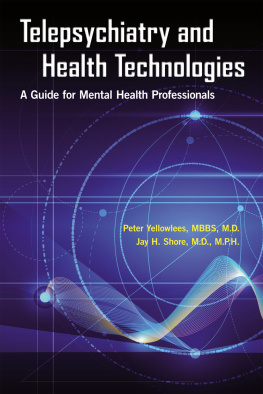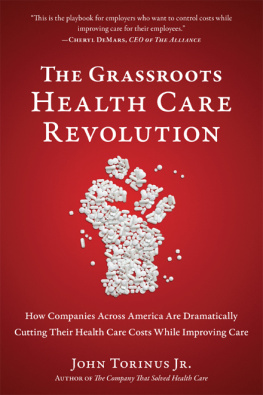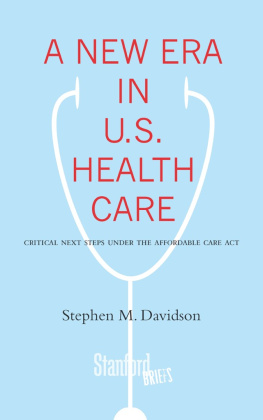A Profile of the Health Management Industry
A Profile of the Health Management Industry
Health Administration for Non-Clinical Professionals
Velma Lee

A Profile of the Health Management Industry: Health Administration for Non-Clinical Professionals
Copyright Business Expert Press, LLC, 2016
All rights reserved. No part of this publication may be reproduced, stored in a retrieval system, or transmitted in any form or by any meanselectronic, mechanical, photocopy, recording, or any other except for brief quotations, not to exceed 250 words, without the prior permission of the publisher.
First published in 2016 by
Business Expert Press, LLC
222 East 46th Street, New York, NY 10017
www.businessexpertpress.com
ISBN-13: 978-1-60649-982-5 (paperback)
ISBN-13: 978-1-60649-983-2 (e-book)
Business Expert Press Industry Profiles Collection
Collection ISSN: 2331-0065 (print)
Collection ISSN: 2331-0073 (electronic)
Cover and interior design by S4Carlisle Publishing Services Private Ltd., Chennai, India
First edition: 2016
10 9 8 7 6 5 4 3 2 1
Abstract
The World Health Organizations (WHO) constitution states that its objective is the attainment by all people of the highest possible level of health (World Health Organization, Constitution of the World Health Organization (PDF), p.1. Accessed 11 November 2013), which includes directing authorities in health policy and work, supplying technical assistance to governments on request during emergencies, and coordinating with the United Nations, governmental health administrations, specialized agencies, and professional groups for effective collaboration. According to the U.S. Census Bureau, a significant component of the healthcare industry in the country comprises establishments with physicians and other medical staff engaged primarily in providing a range of outpatient medical services to health maintenance organization (HMO) subscribers, with focus on primary health care. These establishments are owned by the HMO. Included in this industry are HMOs that both provide healthcare services and underwrite health and medical insurance policies (NCAIS code 621491 refers to HMO medical centers).
Health practitioners or health practitioner groups contracting to provide services to subscribers of prepaid health plans are classified under Industry 62111, Offices of Physicians; Industry 621210, Offices of Dentists; and Industry Group 6213, Offices of Other Health Practitioners. HMOs (except those providing healthcare services) engaged primarily in underwriting and administering health and medical insurance policies are classified under Industry 524114, Direct Health and Medical Insurance Carriers. What will not be discussed in this book are other healthcare approaches, including commercial, welfare, patient, Medicare, employer-direct contracting, and privately paid (i.e., cash-based traditional, chiropractic, naturopathic, etc.)
Health care is traditionally viewed as a science profession, with a public service focus, it now includes major partnering organizations, including the insurance industry, the pharmaceutical industry, academic research centers, various specialization groups, laboratory agencies, social workers, and supermarket chains. Hospitals exist in many organizational forms and structuressole-proprietary clinics, government-funded hospitals, franchised groups, and hybrids that offer both publicly and privately funded services.
Over the last two decades, there are increased offerings of Masters in Health Care Administration degrees offered in various shades and depths by higher educational institutions. Yet, it is difficult to find one text that serves as a central platform for any instructor to build a course upon. Most of the course materials of such a graduate degree come from a variety of reading materials determined by the teaching instructors expertise and resources.
This book is intended for middle- and upper-level managers in healthcare organizations who have no or little clinical training background. Students of healthcare administration and those who would like to enter the field may find it useful.
Keywords
administration, competition, electronic medical record, ethics, healthcare, healthcare leadership, healthcare policy, HMO, human resources, insurance, management, medical centers, strategy
Contents
Whether you are a student considering the health care profession, planning to join the industry as a mid-career seasoned manager, or simply an ordinary citizen whose dear family/friend needs medical treatment, you will find this book useful in giving you information and perspective about the health care industry to ask the right questions.
Arturo BLANCO, M.D.
A significant component of healthcare industry comprises establishments with physicians and other medical staff engaged primarily in providing a range of outpatient medical services to health maintenance organization (HMO) subscribers, with focus on primary health care (NCAIS code 621491 refers to HMO Medical Centers). The healthcare industry also includes insurance, pharmaceuticals, ambulatory services, rehabilitation, and hospitality. This book provides an overview of the industry to nonclinical practitioners to understand selected historical milestones and trends that are significant to healthcare leadership and management.
Pertinent legislations and the industry landscape are changing almost on a daily basis. It is not the intent of this book to provide the readers with most updated trends and information of the field. Rather, it serves as background knowledge and provides some basis for which management new to the healthcare industry can begin asking relevant questions and more in-depth discussions with regard to ones entity or peripheral industry.
This book is not possible without the support and encouragement of manyfirst and foremost, my husband and daughter. I also want to thank my husbands family and relatives, my parents training of my thirst for knowledge and filling gaps where needed, many colleagues and students at Palm Beach Atlantic University and students who helped research and contribute to this piece of work, as well as friends and family in the medical field in California, New York, Florida, Texas, and Washington.
My mentors in the United Kingdom, United States, and Hong Kong who have researched and published in the healthcare industry and practitioners in the field who have offered me their views and reflection over the years have all contributed to the birth of this piece of work.
I am also much indebted to the Business Expert Press teams editorial support, especially Rene Caroline.
offers an overview of the basic elements in a healthcare institution from an organizational perspective. It discusses human resources, core departmental functions, financing, and future challenges.
The healthcare industry is rich in history and development. It has experienced many periods of change and growth. To understand how the industry operates, briefs some historical landmarks, paradigm shift, and changes in physical building code requirements. Legislative requirements and changing regulations impact on relevant constituents highlighted the complex and competitive nature of the industry.
focuses on health care as a hybrid product and service commodity. Health care is analyzed from a marketing perspective. It also highlights changes in demographics, impact of technological advancement, shifting societal values, and patient expectations. This chapter concludes with more elaboration on common human resources issues and challenges. Some data and trends are presented but readers should update their knowledge using the data source provided to get the latest information regarding the industry landscape.










